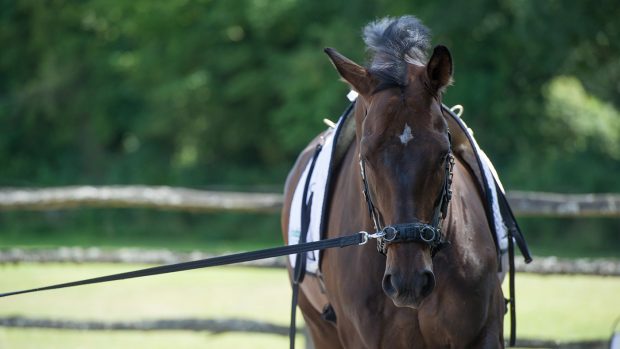The Equiband system is a training aid to help activate your horse’s core. It consists of two lengths of latex-free rubber that attach to a customised saddle pad. The shorter Equiband passes under the horse’s abdomen behind the rider’s leg while the longer piece rests behind the hindquarters under the horse’s tail, sitting above the hock and below the stifle. Both pieces are attached to the saddle pad from left to right and can be used individually or together depending on the reason you are using them.
The bands stimulate receptors in the horse’s skin and hair follicles which then activate the abdominal, sublumbar, deep neck and back muscles. The stimulation of these muscles mobilises the core and hindquarters and stabilises the horse’s back which helps prevent back pain and injuries. The Equiband system also supports and develops balance and coordination.
It is available in four sizes – pony, small, regular or large.
“The bands have a unique tension and texture, promoting optimal proprioceptive stimulation. They do not slide or move during locomotion and that constant contact is important. Cheap or fake copies on the market are made with a human resistance band which is smooth and slides, and therefore the stimulus and input is not the same,” says Dr Nicole Rombach, who devised the product in the US together with Dr Narelle Stubbs.

The pair designed the Equiband system to be used specifically under the guidance of a vet or a licensed professional for horses that have recovered from colic surgery, have poor posture or have been diagnosed with conditions such as kissing spine. The product is also beneficial for horses with asymmetrical hind limb movement, poor engagement and poor development of major muscle groups.
“All horses can use the Equiband system. For young horses it’s ideal to build up core strength without the rider. For rehabilitation, it activates core muscles that have become underactive due to a lack of movement or surgical intervention,” explains Dr Rombach.
“For the healthy horse it’s a way to add conditioning without having to add mileage: the workout is more intense therefore less time is needed under the rider. For the geriatric horse it’s an effective means to keep the core as strong as possible.”
Australian event rider Andrew Hoy regularly uses the product on his horses.
“The Equiband system can be a very good aid if used and fitted correctly. I use it on an individual basis on my young horses and those horses who find it difficult to engage their core or thoracic area. It is really beneficial in activating those muscles which can be hard for us as riders to get the horses to use,” says Andrew.
Findings from a 2015 British Equine Veterinary Association study which looked at quantifying the effect of the Equiband system on back kinematics and movement symmetry stated: “The Equiband system significantly reduced roll, pitch and mediolateral displacement in the cranial‐mid thoracic region. Across all horses, back displacement and range of motion values were significantly greater on the lunge than in a straight line, movement symmetry was consistent with having corrected all horses to be left‐sided. Preliminary results suggest the Equiband system may aid dynamic stabilisation of the vertebral column.”
Continued below…

Subscribe to Horse & Hound magazine today – and enjoy unlimited website access all year round
Initially the Equibands, which attach to an ergonomically shaped saddle pad made from wool and felt, should be used only for short periods of time at the start of a session to avoid muscle fatigue.
“To start with halve the horse’s normal workout and allow plenty of rest breaks. Start with the abdominal band only and add the hindquarter band after two or three weeks. In rehab, daily use is advised while for general conditioning two to three times a week is ideal,” concludes Nicole.
Horse & Hound magazine, out every Thursday, is packed with all the latest news and reports, as well as interviews, specials, nostalgia, vet and training advice. Find how you can enjoy the magazine delivered to your door every week, plus options to upgrade to access our H&H Plus online service which brings you breaking news as it happens as well as other benefits.





